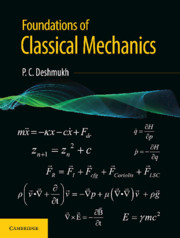Book contents
- Frontmatter
- Dedication
- Contents
- List of Figures
- List of Tables
- Foreword
- Preface
- Introduction
- 1 Laws of Mechanics and Symmetry Principles
- 2 Mathematical Preliminaries
- 3 Real Effects of Pseudo-forces: Description of Motion in Accelerated Frame of Reference
- 4 Small Oscillations and Wave Motion
- 5 Damped and Driven Oscillations; Resonances
- 6 The Variational Principle
- 7 Angular Momentum and Rigid Body Dynamics
- 8 The Gravitational Interaction in Newtonian Mechanics
- 9 Complex Behavior of Simple System
- 10 Gradient Operator, Methods of Fluid Mechanics, and Electrodynamics
- 11 Rudiments of Fluid Mechanics
- 12 Basic Principles of Electrodynamics
- 13 Introduction to the Special Theory of Relativity
- 14 A Glimpse of the General Theory of Relativity
- Index
6 - The Variational Principle
Published online by Cambridge University Press: 06 November 2019
- Frontmatter
- Dedication
- Contents
- List of Figures
- List of Tables
- Foreword
- Preface
- Introduction
- 1 Laws of Mechanics and Symmetry Principles
- 2 Mathematical Preliminaries
- 3 Real Effects of Pseudo-forces: Description of Motion in Accelerated Frame of Reference
- 4 Small Oscillations and Wave Motion
- 5 Damped and Driven Oscillations; Resonances
- 6 The Variational Principle
- 7 Angular Momentum and Rigid Body Dynamics
- 8 The Gravitational Interaction in Newtonian Mechanics
- 9 Complex Behavior of Simple System
- 10 Gradient Operator, Methods of Fluid Mechanics, and Electrodynamics
- 11 Rudiments of Fluid Mechanics
- 12 Basic Principles of Electrodynamics
- 13 Introduction to the Special Theory of Relativity
- 14 A Glimpse of the General Theory of Relativity
- Index
Summary
When I was in high school, my Physics teacher—whose name was Mr Bader—called me down one day after physics class and said, ‘You look bored; I want to tell you something interesting’. Then he told me something which I found absolutely fascinating, and have since then, always found fascinating. Every time the subject comes up, I work on it… The subject is this—the principle of least action.
—Richard P. FeynmanTHE VARIATIONAL PRINCIPLE AND EULER–LAGRANGE'S EQUATION OF MOTION
In the previous chapters, we have worked with the Newtonian formulation of classical mechanics. Its central theme relies on the use of ‘force’ as the very cause of change in momentum. The cornerstone of Newtonian mechanics is this principle of causality. It is expressed in Newton's second law as a linear relation between the acceleration and the force. It is the result of the equality between the force and the rate of change of momentum. The relation between force and momentum is at the very heart of Newtonian formulation of classical mechanics. It turns out that classical mechanics has an alternative but equivalent formulation, based on what is known as the ‘variational principle’, or ‘Hamilton's principle of variation’. In many universities, the principle of variation [1, 2] is introduced after a few years of college education in physics, and after a few courses on mechanics, including electrodynamics. However, there have been a few proposals [3, 4, 5] which recommend an early exposure in college curriculum to this fascinating approach. In fact, Richard Feynman was introduced to the principle of variation by his high school teacher, Mr Bader. Feynman went on to develop the path integral approach to the quantum theory based on the principle of variation. The path integral approach to quantum mechanics provides an alternative formulation of the quantum theory; it is equivalent to Heisenberg's uncertainty principle, and the Schrödinger equation. It has the capacity to describe a mechanical system and to account for how it evolves with time. The variational principle can be adapted to provide a backward integration of classical mechanics as an approximation toward the development of quantum theory. Newtonian formulation is not suitable for this purpose.
- Type
- Chapter
- Information
- Foundations of Classical Mechanics , pp. 183 - 224Publisher: Cambridge University PressPrint publication year: 2019



